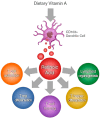Pet Wellness and Vitamin A: A Narrative Overview
- PMID: 38612239
- PMCID: PMC11010875
- DOI: 10.3390/ani14071000
Pet Wellness and Vitamin A: A Narrative Overview
Abstract
The health of companion animals, particularly dogs and cats, is significantly influenced by nutrition, with vitamins playing a crucial role. Vitamin A, in particular, is indispensable, with diverse roles ranging from vision to immune modulation and reproduction. Despite its importance, the metabolism and dietary requirements of vitamin A in companion animals remain complex and not fully understood. This review provides a comprehensive overview of the historical perspective, the digestion, the metabolism, the physiological roles, the deficiency, the excess, and the interactions with other micronutrients of vitamin A in companion animals. Additionally, it highlights future research directions and gaps in our understanding. Insights into the metabolism of vitamin A in companion animals, personalized nutrition strategies based on genetic variability, longitudinal studies tracking the status of vitamin A, and investigations into its immunomodulatory effects are crucial for optimizing pet health and wellness. Furthermore, understanding the stability and bioavailability of vitamin A in pet food formulations is essential for ensuring the provision of adequate micronutrients. Overall, this review underscores the importance of vitamin A in companion animal nutrition and the need for further research to enhance our understanding and to optimize dietary recommendations for pet health and well-being.
Keywords: cat; dog; health; pets; vitamin A; well-being.
Conflict of interest statement
Both authors of this work are affiliated with BASF, a manufacturer of vitamins and carotenoids, including vitamin A and β-carotene. Nevertheless, it is crucial to underscore that the content of this manuscript has been sourced exclusively from scientific peer-reviewed data. Our unwavering commitment lies in upholding transparency and adhering to ethical research principles.
Figures






Similar articles
-
COMPANION ANIMALS SYMPOSIUM: Future aspects and perceptions of companion animal nutrition and sustainability.J Anim Sci. 2015 Mar;93(3):823-34. doi: 10.2527/jas.2014-8520. J Anim Sci. 2015. PMID: 26020861 Review.
-
Recent Advances in the Nutrition and Metabolism of Dogs and Cats.Adv Exp Med Biol. 2024;1446:1-14. doi: 10.1007/978-3-031-54192-6_1. Adv Exp Med Biol. 2024. PMID: 38625522
-
Disease Risk Assessments Involving Companion Animals: an Overview for 15 Selected Pathogens Taking a European Perspective.J Comp Pathol. 2016 Jul;155(1 Suppl 1):S75-97. doi: 10.1016/j.jcpa.2015.08.003. Epub 2015 Sep 28. J Comp Pathol. 2016. PMID: 26422413 Review.
-
Effects of nutrients (in food) on the structure and function of the nervous system: update on dietary requirements for brain. Part 1: micronutrients.J Nutr Health Aging. 2006 Sep-Oct;10(5):377-85. J Nutr Health Aging. 2006. PMID: 17066209 Review.
-
Vitamin D metabolism and disorders in dogs and cats.J Small Anim Pract. 2021 Nov;62(11):935-947. doi: 10.1111/jsap.13401. Epub 2021 Jul 29. J Small Anim Pract. 2021. PMID: 34323302 Review.
Cited by
-
Review of Liquid Vitamin A and E Formulations in Veterinary and Livestock Production: Applications and Perspectives.Vet Sci. 2024 Sep 9;11(9):421. doi: 10.3390/vetsci11090421. Vet Sci. 2024. PMID: 39330800 Free PMC article. Review.
-
Vitamins, Minerals and Phytonutrients as Modulators of Canine Immune Function: A Literature Review.Vet Sci. 2024 Dec 16;11(12):655. doi: 10.3390/vetsci11120655. Vet Sci. 2024. PMID: 39728995 Free PMC article. Review.
References
-
- Shastak Y., Gordillo A., Pelletier W. The relationship between vitamin A status and oxidative stress in animal production. J. Appl. Anim. Res. 2023;51:546–553. doi: 10.1080/09712119.2023.2239319. - DOI
-
- Shastak Y., Pelletier W. The role of vitamin A in non-ruminant immunology. Front. Anim. Sci. 2023;4:1197802. doi: 10.3389/fanim.2023.1197802. - DOI
Publication types
LinkOut - more resources
Full Text Sources
Miscellaneous

